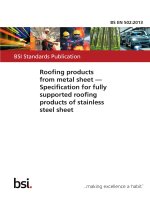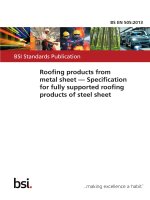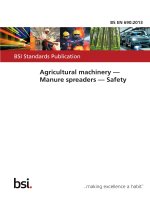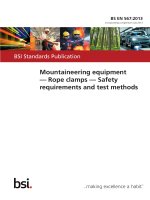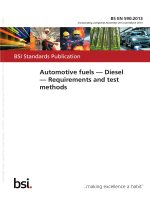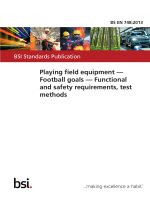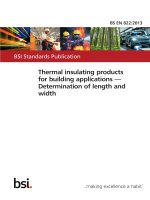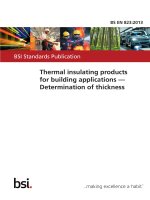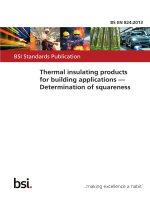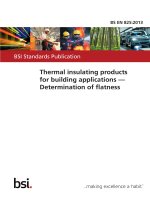Bsi bs en 62133 2013
Bạn đang xem bản rút gọn của tài liệu. Xem và tải ngay bản đầy đủ của tài liệu tại đây (1.56 MB, 40 trang )
BS EN 62133:2013
BSI Standards Publication
Secondary cells and
batteries containing alkaline
or other non-acid electrolytes
— Safety requirements for
portable sealed secondary
cells, and for batteries made
from them, for use in
portable applications
BS EN 62133:2013 BRITISH STANDARD
National foreword
This British Standard is the UK implementation of EN 62133:2013. It is
identical to IEC 62133:2012, incorporating corrigendum June 2013. It
supersedes BS EN 62133:2003 which is withdrawn.
IEC corrigendum June 2013 replaces the text of 10.1 Cell marking.
The UK participation in its preparation was entrusted by Technical
Committee PEL/21, Secondary cells and batteries, to Subcommittee
PEL/21/1, Secondary cells and batteries containing alkaline and other
non‑acidic electrolytes.
A list of organizations represented on this subcommittee can be
obtained on request to its secretary.
This publication does not purport to include all the necessary provisions
of a contract. Users are responsible for its correct application.
© The British Standards Institution 2013.
Published by BSI Standards Limited 2013
ISBN 978 0 580 63064 4
ICS 29.220.30
Compliance with a British Standard cannot confer immunity from
legal obligations.
This British Standard was published under the authority of the Standards
Policy and Strategy Committee on 30 September 2013.
Amendments/corrigenda issued since publication
Date Text affected
EUROPEAN STANDARD EN 62133 BS EN 62133:2013
NORME EUROPÉENNE
EUROPÄISCHE NORM March 2013 Supersedes EN 62133:2003
ICS 29.220.30 English version
Secondary cells and batteries containing alkaline or other non-acid
electrolytes -
Safety requirements for portable sealed secondary cells, and for batteries
made from them, for use in portable applications
(IEC 62133:2012)
Accumulateurs alcalins et autres Akkumulatoren und Batterien mit
accumulateurs à électrolyte non acide - alkalischen oder anderen nicht
Exigences de sécurité pour les säurehaltigen Elektrolyten -
accumulateurs portables étanches, et Sicherheitsanforderungen für tragbare
pour les batteries qui en sont constituées, gasdichte Akkumulatoren und daraus
destinés à l'utilisation dans des hergestellte Batterien für die Verwendung
applications portables in tragbaren Geräten
(CEI 62133:2012) (IEC 62133:2012)
This European Standard was approved by CENELEC on 2013-01-10. CENELEC members are bound to comply
with the CEN/CENELEC Internal Regulations which stipulate the conditions for giving this European Standard
the status of a national standard without any alteration.
Up-to-date lists and bibliographical references concerning such national standards may be obtained on
application to the CEN-CENELEC Management Centre or to any CENELEC member.
This European Standard exists in three official versions (English, French, German). A version in any other
language made by translation under the responsibility of a CENELEC member into its own language and notified
to the CEN-CENELEC Management Centre has the same status as the official versions.
CENELEC members are the national electrotechnical committees of Austria, Belgium, Bulgaria, Croatia, Cyprus,
the Czech Republic, Denmark, Estonia, Finland, Former Yugoslav Republic of Macedonia, France, Germany,
Greece, Hungary, Iceland, Ireland, Italy, Latvia, Lithuania, Luxembourg, Malta, the Netherlands, Norway, Poland,
Portugal, Romania, Slovakia, Slovenia, Spain, Sweden, Switzerland, Turkey and the United Kingdom.
CENELEC European Committee for Electrotechnical Standardization
Comité Européen de Normalisation Electrotechnique
Europäisches Komitee für Elektrotechnische Normung
Management Centre: Avenue Marnix 17, B - 1000 Brussels
© 2013 CENELEC - All rights of exploitation in any form and by any means reserved worldwide for CENELEC members.
Ref. No. EN 62133:2013 E
BS EN 62133:2013
EN 62133:2013 - 2 -
Foreword
The text of document 21A/503/FDIS, future edition 2 of IEC 62133, prepared by SC 21A, "Secondary cells
and batteries containing alkaline or other non-acid electrolytes", of IEC TC 21, "Secondary cells and
batteries" was submitted to the IEC-CENELEC parallel vote and approved by CENELEC as
EN 62133:2013.
The following dates are fixed:
• latest date by which the document has (dop) 2013-10-10
to be implemented at national level by (dow) 2016-01-10
publication of an identical national
standard or by endorsement
• latest date by which the national
standards conflicting with the
document have to be withdrawn
This document supersedes EN 62133:2003.
EN 62133:2013 includes the following significant technical changes with respect to EN 62133:2003:
– update of assembly of cells into batteries (5.5);
– addition of design recommendations for lithium system only (5.6.2);
– separation of nickel systems and lithium systems (Clause 6);
– addition of specific requirements and tests for lithium systems (Clause 8);
– addition of charging of secondary lithium-ion cells for safe use (Annex A).
Attention is drawn to the possibility that some of the elements of this document may be the subject of
patent rights. CENELEC [and/or CEN] shall not be held responsible for identifying any or all such patent
rights.
Endorsement notice
The text of the International Standard IEC 62133:2012 was approved by CENELEC as a European
Standard without any modification.
In the official version, for Bibliography, the following notes have to be added for the standards indicated:
IEC 60051 series NOTE Harmonized in EN 60051 series.
IEC 60664 series NOTE Harmonized in EN 60664 series.
IEC 61434 NOTE Harmonized as EN 61434.
IEC 62281 NOTE Harmonized as EN 62281.
BS EN 62133:2013
- 3 - EN 62133:2013
Annex ZA
(normative)
Normative references to international publications
with their corresponding European publications
The following documents, in whole or in part, are normatively referenced in this document and are
indispensable for its application. For dated references, only the edition cited applies. For undated
references, the latest edition of the referenced document (including any amendments) applies.
NOTE When an international publication has been modified by common modifications, indicated by (mod), the relevant EN/HD
applies.
Publication Year Title EN/HD Year
IEC 60050-482 - - -
International Electrotechnical Vocabulary EN 61951-1 -
IEC 61951-1 - (IEV) - EN 61951-2 -
Part 482: Primary and secondary cells and EN 61960 -
IEC 61951-2 - batteries - -
IEC 61960 - Secondary cells and batteries containing
alkaline or other non-acid electrolytes -
ISO/IEC Guide 51 - Portable sealed rechargeable single cells -
Part 1: Nickel-cadmium
Secondary cells and batteries containing
alkaline or other non-acid electrolytes -
Portable sealed rechargeable single cells -
Part 2: Nickel-metal hydride
Secondary cells and batteries containing
alkaline or other non-acid electrolytes -
Secondary lithium cells and batteries for
portable applications
Safety aspects - Guidelines for their inclusion
in standards
– 2 – BS EN 62133:2013
62133 © IEC:2012
CONTENTS
1 Scope...............................................................................................................................6
2 Normative references .......................................................................................................6
3 Terms and definitions .......................................................................................................6
4 Parameter measurement tolerances .................................................................................8
5 General safety considerations ..........................................................................................8
5.1 General ...................................................................................................................8
5.2 Insulation and wiring ...............................................................................................9
5.3 Venting....................................................................................................................9
5.4 Temperature/voltage/current management ..............................................................9
5.5 Terminal contacts ....................................................................................................9
5.6 Assembly of cells into batteries ...............................................................................9
5.6.1 General .......................................................................................................9
5.6.2 Design recommendation for lithium systems only.......................................10
5.7 Quality plan ........................................................................................................... 10
6 Type test conditions ....................................................................................................... 10
7 Specific requirements and tests (nickel systems) ............................................................ 11
7.1 Charging procedure for test purposes....................................................................11
7.2 Intended use ......................................................................................................... 12
7.2.1 Continuous low-rate charging (cells) ..........................................................12
7.2.2 Vibration .................................................................................................... 12
7.2.3 Moulded case stress at high ambient temperature (batteries) ....................12
7.2.4 Temperature cycling .................................................................................. 13
7.3 Reasonably foreseeable misuse ............................................................................13
7.3.1 Incorrect installation (cells) ........................................................................ 13
7.3.2 External short circuit..................................................................................14
7.3.3 Free fall ..................................................................................................... 14
7.3.4 Mechanical shock (crash hazard)...............................................................14
7.3.5 Thermal abuse (cells) ................................................................................15
7.3.6 Crushing of cells........................................................................................15
7.3.7 Low pressure (cells) .................................................................................. 15
7.3.8 Overcharge................................................................................................ 15
7.3.9 Forced discharge (cells) ............................................................................ 16
8 Specific requirements and tests (lithium systems)........................................................... 16
8.1 Charging procedures for test purposes ..................................................................16
8.1.1 First procedure .......................................................................................... 16
8.1.2 Second procedure ..................................................................................... 16
8.2 Intended use ......................................................................................................... 17
8.2.1 Continuous charging at constant voltage (cells) .........................................17
8.2.2 Moulded case stress at high ambient temperature (battery) .......................17
8.3 Reasonably foreseeable misuse ............................................................................17
8.3.1 External short circuit (cell) ......................................................................... 17
8.3.2 External short circuit (battery).................................................................... 17
8.3.3 Free fall ..................................................................................................... 18
8.3.4 Thermal abuse (cells) ................................................................................18
BS EN 62133:2013 – 3 –
62133 © IEC:2012
8.3.5 Crush (cells) .............................................................................................. 18
8.3.6 Over-charging of battery ............................................................................18
8.3.7 Forced discharge (cells) ............................................................................ 19
8.3.8 Transport tests .......................................................................................... 19
8.3.9 Design evaluation – Forced internal short circuit (cells) .............................19
9 Information for safety......................................................................................................21
10 Marking .......................................................................................................................... 21
10.1 Cell marking .......................................................................................................... 21
10.2 Battery marking .....................................................................................................22
10.3 Other information .................................................................................................. 22
11 Packaging ...................................................................................................................... 22
Annex A (normative) Charging range of secondary lithium ion cells for safe use ..................23
Annex B (informative) Recommendations to equipment manufacturers and battery
assemblers ........................................................................................................................... 34
Annex C (informative) Recommendations to the end-users ..................................................35
Bibliography.......................................................................................................................... 36
Figure 1 – Temperature profile for 7.2.4 – Temperature cycling test......................................13
Figure 2 – Jig for pressing .................................................................................................... 21
Figure A.1 – Typical of operating region of Li-ion cells with cobalt oxide cathode and
carbon anode........................................................................................................................ 24
Figure A.2 – Shape of nickel particle.....................................................................................28
Figure A.3 – Nickel particle insertion position between positive and negative active
material coated area of cylindrical cell ..................................................................................29
Figure A.4 – Nickel particle insertion position between positive aluminum foil and
negative active material coated area of cylindrical cell .......................................................... 29
Figure A.5 – Disassembly of cylindrical cell .......................................................................... 30
Figure A.6 – Nickel particle insertion position between positive and negative (active
material) coated area of prismatic cell...................................................................................31
Figure A.7 – Nickel particle insertion position between positive aluminum foil and
negative (active material) coated area of prismatic cell .........................................................32
Figure A.8 – Disassembly of prismatic cells ..........................................................................33
Table 1 – Sample size for type tests (nickel systems) ........................................................... 11
Table 2 – Sample size for type tests (lithium systems) .......................................................... 11
Table 3 – Conditions for vibration test ................................................................................... 12
Table 4 – Condition of charging procedure............................................................................16
Table 5 – Ambient temperature for cell test a ........................................................................20
– 6 – BS EN 62133:2013
62133 © IEC:2012
SECONDARY CELLS AND BATTERIES CONTAINING ALKALINE
OR OTHER NON-ACID ELECTROLYTES –
SAFETY REQUIREMENTS FOR PORTABLE SEALED
SECONDARY CELLS, AND FOR BATTERIES MADE FROM THEM,
FOR USE IN PORTABLE APPLICATIONS
1 Scope
This International Standard specifies requirements and tests for the safe operation of portable
sealed secondary cells and batteries (other than button) containing alkaline or other non-acid
electrolyte, under intended use and reasonably foreseeable misuse.
2 Normative references
The following documents, in whole or in part, are normatively referenced in this document and
are indispensable for its application. For dated references, only the edition cited applies. For
undated references, the latest edition of the referenced document (including any
amendments) applies.
IEC 60050-482, International Electrotechnical Vocabulary – Part 482: Primary and secondary
cells and batteries
IEC 61951-1, Secondary cells and batteries containing alkaline or other non-acid electrolytes
– Portable sealed rechargeable single cells – Part 1: Nickel-cadmium
IEC 61951-2, Secondary cells and batteries containing alkaline or other non-acid electrolytes
– Portable sealed rechargeable single cells – Part 2: Nickel-metal hydride
IEC 61960, Secondary cells and batteries containing alkaline or other non-acid electrolytes –
Secondary lithium cells and batteries for portable applications
ISO/IEC Guide 51, Safety aspects – Guidelines for their inclusion in standards
3 Terms and definitions
For the purposes of this document, the terms and definitions given in IEC 60050-482 and
ISO/IEC Guide 51, as well as the following apply.
3.1
safety
freedom from unacceptable risk
3.2
risk
a combination of the probability of occurrence of harm and the severity of that harm
3.3
harm
physical injury or damage to the health of people or damage to property or to the environment
BS EN 62133:2013 – 7 –
62133 © IEC:2012
3.4
hazard
potential source of harm
3.5
intended use
use of a product, process or service in accordance with specifications, instructions and
information provided by the supplier
3.6
reasonably foreseeable misuse
use of a product, process or service in a way which is not intended by the supplier, but which
may result from readily predictable human behaviour
3.7
secondary cell
basic manufactured unit providing a source of electrical energy by direct conversion of
chemical energy, that consists of electrodes, separators, electrolyte, container and terminals,
and that is designed to be charged electrically
3.8
secondary battery
assembly of secondary cell(s) ready for use as a source of electrical energy characterized by
its voltage, size, terminal arrangement, capacity and rate capability
3.9
leakage
visible escape of liquid electrolyte
3.10
venting
release of excessive internal pressure from a cell/battery in a manner intended by design to
preclude rupture or explosion
3.11
rupture
mechanical failure of a cell container or battery case induced by an internal or external cause,
resulting in exposure or spillage but not ejection of materials
3.12
explosion
failure that occurs when a cell container or battery case opens violently and major
components are forcibly expelled
3.13
fire
the emission of flames from a cell or battery
3.14
portable battery
a battery for use in a device or appliance which is conveniently hand carried
3.15
portable cell
a cell intended for assembly in a portable battery
– 8 – BS EN 62133:2013
62133 © IEC:2012
3.16
polymer cell
cell using gel polymer electrolyte or solid polymer electrolyte, not liquid electrolyte
3.17
rated capacity
quantity of electricity C5 Ah (ampere-hours) declared by the manufacturer which a single cell
can deliver when discharged at the reference test current of 0,2 It A to a specified final
voltage, after charging, storing and discharging under specified conditions
3.18
upper limit charging voltage
the highest charging voltage in the cell operating region specified by the cell manufacturer
3.19
maximum charging current
the maximum charging current in the cell operating region which is specified by the cell
manufacturer
4 Parameter measurement tolerances
The overall accuracy of controlled or measured values, relative to the specified or actual
parameters, shall be within these tolerances.
a) ± 1 % for voltage;
b) ± 1 % for current;
c) ± 2 °C for temperature;
d) ± 0,1 % for time;
e) ± 1 % for dimension;
f) ± 1 % for capacity.
These tolerances comprise the combined accuracy of the measuring instruments, the
measurement techniques used, and all other sources of error in the test procedure.
For assistance in selecting instrumentation see IEC 60051 series for analogue instruments
and IEC 60485 for digital instruments. The details of the instrumentation used shall be
provided in any report of results.
5 General safety considerations
5.1 General
The safety of secondary cells and batteries requires the consideration of two sets of applied
conditions:
• intended use;
• reasonably foreseeable misuse.
Cells and batteries shall be so designed and constructed that they are safe under conditions
of both intended use and reasonably foreseeable misuse. It is expected that cells or batteries
subjected to misuse may fail to function following such experience. They shall not however
present significant hazards. It may also be expected that cells and batteries subjected to
intended use shall not only be safe but shall continue to be functional in all respects.
Potential hazards which are the subject of this standard are:
BS EN 62133:2013 – 9 –
62133 © IEC:2012
a) fire,
b) burst/explosion,
c) leakage of cell electrolyte,
d) venting,
e) burns from excessively high external temperatures,
f) rupture of battery case with exposure of internal components.
Conformity with 5.2 to 5.7 is checked by inspection, by the tests of Clauses 7 and 8, and in
accordance with the appropriate standard (see Clause 2).
5.2 Insulation and wiring
The insulation resistance between the positive terminal and externally exposed metal surfaces
of the battery excluding electrical contact surfaces shall be not less than 5 MΩ at 500 V d. c.
when measured 60 s after applying the voltage.
Internal wiring and its insulation shall be sufficient to withstand the maximum anticipated
current, voltage and temperature requirements. The orientation of wiring shall be such that
adequate clearances and creepage distances are maintained between connectors. The
mechanical integrity of internal connections shall be sufficient to accommodate conditions of
reasonably foreseeable misuse.
5.3 Venting
Battery cases and cells shall incorporate a pressure relief mechanism or shall be so
constructed that they will relieve excessive internal pressure at a value and rate that will
preclude rupture, explosion and self-ignition. If encapsulation is used to support cells within
an outer case, the type of encapsulant and the method of encapsulation shall neither cause
the battery to overheat during normal operation nor inhibit pressure relief.
5.4 Temperature/voltage/current management
The design of batteries shall be such that abnormal temperature-rise conditions are
prevented. Batteries shall be designed to be within temperature, voltage and current limits
specified by the cell manufacturer. Batteries shall be provided with specifications and
charging instructions for equipment manufacturers so that associated chargers are
designed to maintain charging within the temperature, voltage and current limits specified.
NOTE Where necessary, means can be provided to limit current to safe levels during charge and discharge.
5.5 Terminal contacts
Terminals shall have clear polarity marking on the external surface of the battery. The size
and shape of the terminal contacts shall ensure that they can carry the maximum anticipated
current. External terminal contact surfaces shall be formed from conductive materials with
good mechanical strength and corrosion resistance. Terminal contacts shall be arranged so
as to minimize the risk of short circuits.
NOTE Exception: Battery packs with keyed external connectors designed for connection to specific end products
need not be marked with polarity markings if the design of the external connector prevents reverse polarity
connections.
5.6 Assembly of cells into batteries
5.6.1 General
If there is more than one battery housed in a single battery case, cells used in the assembly
of each battery shall have closely matched capacities, be of the same design, be of the same
– 10 – BS EN 62133:2013
62133 © IEC:2012
chemistry and be from the same manufacturer. Each battery shall have an independent
control and protection. Manufacturers of cells shall make recommendations about current,
voltage and temperature limits so that the battery manufacturer/designer may ensure proper
design and assembly. Batteries that are designed for the selective discharge of a portion of
their series connected cells shall incorporate separate circuitry to prevent the cell reversal
caused by uneven discharges. Protective circuit components should be added as appropriate
and consideration given to the end-device application. When testing a battery, the
manufacturer of the battery shall provide a test report confirming the compliance according to
this standard. Conformity shall be checked by inspection.
5.6.2 Design recommendation for lithium systems only
The voltage of each cell, or each cellblock consisting of parallel-connected plural cells, should
not exceed the upper limit of the charging voltage specified in Table 4, excepting the case
where the portable electronic devices or the likes have the equivalent function.
The following should be considered at the battery pack level and by the device designer:
• for the battery consisting of a single cell or a single cellblock, it is recommended that the
charging voltage of the cell does not exceed the upper limit of the charging voltage
specified in Table 4;
• for the battery consisting of series-connected plural single cells or series-connected plural
cellblocks, it is recommended that the voltages of any one of the single cells or single
cellblocks does not exceed the upper limit of the charging voltage, specified in Table 4, by
monitoring the voltage of every single cell or the single cellblocks;
• for the battery consisting of series-connected plural single cells or series-connected plural
cellblocks, it is recommended that charging is stopped when the upper limit of the
charging voltage is exceeded for any one of the single cells or single cellblocks by
measuring the voltage of every single cell or the single cellblocks.
5.7 Quality plan
The manufacturer shall prepare and implement a quality plan that defines procedures for the
inspection of materials, components, cells and batteries and which covers the whole process
of producing each type of cell or battery. Manufacturers should understand their process
capabilities and should institute the necessary process controls as they relate to product
safety.
6 Type test conditions
Tests are made with the number of cells or batteries specified in Table 1 for nickel-cadmium
and nickel-metal hydride systems and Table 2 for lithium systems, using cells or batteries that
are not more than six months old. Unless otherwise specified, tests are carried out in an
ambient temperature of 20 °C ± 5 °C.
NOTE Test conditions are for type tests only and do not imply that intended use includes operation under these
conditions. Similarly, the limit of six months is introduced for consistency and does not imply that battery safety is
reduced after six months.
BS EN 62133:2013 – 11 –
62133 © IEC:2012
Table 1 – Sample size for type tests (nickel systems)
Test Cell Battery
7.2.1 Low rate charging 5 –
7.2.2 Vibration 5 5
7.2.3 Moulded case stress – 3
7.2.4 Temperature cycling 5 5
7.3.1 Incorrect Installation –
7.3.2 External short circuit 5 sets of 4
7.3.3 Free fall 5 /Temperature 5 /Temperature
7.3.4 Mechanical shock 3
7.3.5 Thermal abuse 3 5
7.3.6 Crush 5 –
7.3.7 Low pressure 5 –
7.3.8 Overcharge 5 (10 for prismatic) –
7.3.9 Forced discharge 3 5
5 –
5
Table 2 – Sample size for type tests (lithium systems)
Test Cell Battery
5/Temp/Condition
8.1.2 Charge (Procedure 2) 5/Temp/Condition
-
8.2.1 Continuous charge 5 3
-
8.2.2 Moulded case stress - 5/Temp
3
8.3.1 External short circuit 5/Temp -
-
8.3.2 External short circuit – 5
-
8.3.3 Free fall 3 -
-
8.3.4 Thermal abuse 5/Temp
8.3.5 Crush 5/Temp
8.3.6 Overcharge -
8.3.7 Forced Discharge 5
8.3.8 Transport (20)
8.3.9 Forced Internal Short a 10
a Country specific test : only required for listed countries.
7 Specific requirements and tests (nickel systems)
7.1 Charging procedure for test purposes
Unless otherwise stated in this standard, the charging procedure for test purposes is carried
out in an ambient temperature of 20 °C ± 5 °C, using the method declared by the
manufacturer.
Prior to charging, the battery shall have been discharged at 20 °C ± 5 °C at a constant current
of 0,2 It A down to a specified final voltage.
– 12 – BS EN 62133:2013
62133 © IEC:2012
Warning: THESE TESTS USE PROCEDURES WHICH MAY RESULT IN HARM IF ADEQUATE PRECAUTIONS
ARE NOT TAKEN. TESTS SHOULD ONLY BE PERFORMED BY QUALIFIED AND EXPERIENCED
TECHNICIANS USING ADEQUATE PROTECTION. TO PREVENT BURNS, CAUTION SHOULD BE
TAKEN FOR THOSE CELLS OR BATTERIES WHOSE CASINGS MAY EXCEED 75 °C AS A
RESULT OF TESTING.
7.2 Intended use
7.2.1 Continuous low-rate charging (cells)
a) Requirement
A continuous low-rate charge shall not cause fire or explosion.
b) Test
Fully charged cells are subjected for 28 days to a charge as specified by the
manufacturer.
c) Acceptance criteria
No fire, no explosion.
7.2.2 Vibration
a) Requirements
Vibration encountered during transportation shall not cause leakage, fire or explosion.
b) Test
Fully charged cells or batteries are vibration-tested under the following test conditions and
the sequence in Table 3. A simple harmonic motion is applied to the cells or batteries with
an amplitude of 0,76 mm, and a total maximum excursion of 1,52 mm. The frequency is
varied at the rate of 1 Hz/min between the limits of 10 Hz and 55 Hz. The entire range of
frequencies (10 Hz to 55 Hz) and return (55 Hz to 10 Hz) is traversed in 90 min ± 5 min for
each mounting position (direction of vibration). The vibration is applied in each of three
mutually perpendicular directions, in the sequence specified below.
Step 1: Verify that the measured voltage is typical of the charged product being tested.
Steps 2-4: Apply the vibration as specified in Table 3.
Step 5: Rest cell for 1 h, and then make a visual inspection.
c) Acceptance criteria
No fire, no explosion, no leakage.
Table 3 – Conditions for vibration test
Step Rest time Vibration time Visual examination
h min
1 Pre-test
2 – – –
3 – 90 ± 5 –
4 – 90 ± 5 –
5 – 90 ± 5
1 Post-test
–
7.2.3 Moulded case stress at high ambient temperature (batteries)
a) Requirement
Internal components of batteries shall not be exposed during use at high temperature.
BS EN 62133:2013 – 13 –
62133 © IEC:2012
b) Test
Fully charged batteries are exposed to a moderately high temperature to evaluate case
integrity. The battery is placed in an air circulating oven at a temperature of 70 °C ± 2 °C.
The batteries remain in the oven for 7 h, after which they are removed and allowed to
return to room temperature.
c) Acceptance criteria
No physical distortion of the battery case resulting in exposure of internal components.
7.2.4 Temperature cycling
a) Requirements
Repeated exposure to high and low temperatures shall not cause fire or explosion.
b) Test according to the following procedure and the profile shown in Figure 1.
Fully charged cells or batteries are subjected to temperature cycling (–20 °C, +75 °C),
in forced draught chambers, according to the following procedure.
Step 1: Place the cells or batteries in an ambient temperature of 75 °C ± 2 °C for 4 h.
Step 2: Change the ambient temperature to 20 °C ± 5 °C within 30 min and maintain
at this temperature for a minimum of 2 h.
Step 3: Change the ambient temperature to –20 °C ± 2 °C within 30 min and maintain
at this temperature for 4 h.
Step 4: Change the ambient temperature to 20 °C ± 5 °C within 30 min and maintain
at this temperature for a minimum of 2 h.
Step 5: Repeat steps 1 to 4 for a further four cycles.
Step 6: After the fifth cycle, store the cells or batteries and check after a rest period of
at least 24 h.
NOTE This test can be performed in a single chamber whose temperature is changed or in three separate
chambers at three different test temperatures.
c) Acceptance criteria
No fire, no explosion, no leakage.
80
60
Temperature (°C) 40
20
0
–20
–40
–60
0 1 2 3 4 5 6 7 8 9 10 11 12 13 14
Time (h) IEC 2194/12
Figure 1 – Temperature profile for 7.2.4 –
Temperature cycling test
7.3 Reasonably foreseeable misuse
7.3.1 Incorrect installation (cells)
a) Requirements
The incorrect installation of a single cell in a multi-cell application shall not cause fire or
explosion.
b) Test
– 14 – BS EN 62133:2013
62133 © IEC:2012
Fully charged cells are evaluated under conditions in which one of the cells is incorrectly
installed. Four fully charged single cells of the same brand, type, size and age are
connected in series with one of the four cells reversed. The resultant assembly is
connected across a resistor of 1 Ω until the vent opens or until the temperature of the
reversed cell returns to ambient temperature. Alternatively, a stabilized d.c. power supply
can be used to simulate the conditions imposed on the reversed cell.
c) Acceptance criteria
No fire, no explosion.
7.3.2 External short circuit
a) Requirements
Short-circuiting of the positive and negative terminals shall not cause fire or explosion.
b) Test
Two sets of fully charged cells or batteries are stored in an ambient temperature
of 20 °C ± 5 °C and +55 °C ± 5 °C respectively. Each cell or battery is then short-circuited
by connecting the positive and negative terminals with a total external resistance
of 80 mΩ ± 20 mΩ. The cells or batteries remain on test for 24 h or until the case
temperature declines by 20 % of the maximum temperature rise, whichever is the sooner.
c) Acceptance criteria
No fire, no explosion.
7.3.3 Free fall
a) Requirements
Dropping a cell or battery (for example, from a bench top) shall not cause fire or
explosion.
b) Test
Each fully charged cell or battery is dropped three times from a height of 1,0 m onto a
concrete floor. The cells or batteries are dropped so as to obtain impacts in random
orientations. After the test, the sample shall be put on rest for a minimum of one hour and
then a visual inspection shall be performed.
c) Acceptance criteria
No fire, no explosion.
7.3.4 Mechanical shock (crash hazard)
a) Requirements
Shocks encountered during handling or transportation shall not cause fire, explosion or
leakage.
b) Test
The fully charged cell or battery is secured to the testing machine by means of a rigid
mount which will support all mounting surfaces of the cell or battery. The cell or battery is
subjected to a total of three shocks of equal magnitude. The shocks are applied in each of
three mutually perpendicular directions. At least one of them shall be perpendicular to a
flat face.
For each shock the cell or battery is accelerated in such a manner that during the initial
3 ms the minimum average acceleration is 75 gn. The peak acceleration shall be between
125 gn and 175 gn. Cells or batteries are tested in an ambient temperature
of 20 °C ± 5 °C. After the test, the sample shall be put on rest for a minimum of one hour
and then a visual inspection shall be performed.
c) Acceptance criteria
No fire, no explosion, no leakage.
BS EN 62133:2013 – 15 –
62133 © IEC:2012
7.3.5 Thermal abuse (cells)
a) Requirements
An extremely high temperature shall not cause fire or explosion.
b) Test
Each fully charged cell, stabilized at room temperature, is placed in a gravity or circulating
air-convection oven. The oven temperature is raised at a rate of 5 °C/min ± 2 °C/min to a
temperature of 130 °C ± 2 °C. The cell remains at this temperature for 10 min before the
test is discontinued.
c) Acceptance criteria
No fire, no explosion.
7.3.6 Crushing of cells
a) Requirements
Severe crushing of a cell (for example, during disposal in a waste compactor) shall not
cause fire or explosion.
b) Test
Each fully charged cell is crushed between two flat surfaces. The force for the crushing is
applied by a hydraulic ram exerting a force of 13 kN ± 1 kN. The crushing is performed in
a manner that will cause the most adverse result. Once the maximum force has been
applied, or an abrupt voltage drop of one-third of the original voltage has been obtained,
the force is released.
A cylindrical or prismatic cell is crushed with its longitudinal axis parallel to the flat
surfaces of the crushing apparatus. To test both wide and narrow sides of prismatic cells,
a second set of cells is tested, rotated 90° around their longitudinal axes compared to the
first set.
c) Acceptance criteria
No fire, no explosion.
7.3.7 Low pressure (cells)
a) Requirements
Low pressure (for example, during transportation in an aircraft cargo hold) shall not cause
fire or explosion.
b) Test
Each fully charged cell is placed in a vacuum chamber, in an ambient temperature
of 20 °C ± 5 °C. Once the chamber has been sealed, its internal pressure is gradually
reduced to a pressure equal to or less than 11,6 kPa (this simulates an altitude of
15 240 m) held at that value for 6 h.
c) Acceptance criteria
No fire, no explosion, no leakage.
7.3.8 Overcharge
a) Requirements
Charging for longer periods and at a higher rate than specified by the manufacturer shall
not cause fire or explosion.
b) Test
A discharged cell or battery is subjected to a high-rate charge of 2,5 times the
recommended charging current for a time that produces a 250 % charge input (250 % of
rated capacity).
c) Acceptance criteria
No fire, no explosion.
– 16 – BS EN 62133:2013
62133 © IEC:2012
7.3.9 Forced discharge (cells)
a) Requirements
A cell in a multi-cell application shall withstand polarity reversal without causing fire or
explosion.
b) Test
A discharged cell is subjected to a reverse charge at 1 It A for 90 min.
c) Acceptance criteria
No fire, no explosion.
8 Specific requirements and tests (lithium systems)
8.1 Charging procedures for test purposes
8.1.1 First procedure
(This charging procedure applies to subclauses other than those specified in 8.1.2)
Unless otherwise stated in this standard, the charging procedure for test purposes is carried
out in an ambient temperature of 20 °C ± 5 °C, using the method declared by the
manufacturer.
Prior to charging, the battery shall have been discharged at 20 °C ± 5 °C at a constant current
of 0,2 It A down to a specified final voltage.
8.1.2 Second procedure
(This charging procedure applies only to 8.3.1, 8.3.2, 8.3.4, 8.3.5, and 8.3.9)
After stabilization for 1 to 4 hours respectively at ambient temperature of highest test
temperature and lowest test temperature, as specified in Table 4 (currently for lithium cobalt
oxide), cells are charged by using the upper limited charging voltage and maximum charging
current, until the charging current is reduced to 0,05 It A, using a constant voltage charging
method.
Table 4 – Condition of charging procedure
Upper limit Maximum charging current Charging temp. Charging temp.
charging voltage Upper limit Lower limit
Specified by the manufacturer 10 °C
4,25 V/cell of cells 45 °C
If a cell’s specified upper and/or lower charging temperature exceeds values for the upper
and/or lower limit test temperatures of Table 4, the cell shall be charged, and if applicable
tested, at the specified values plus 5 °C for the upper limit and minus 5 °C for the lower limit.
The cells shall fulfil the criteria of 8.3.1, 8.3.2, 8.3.4, 8.3.5, and 8.3.9. There shall also be a
valid rationale provided regarding how the cell’s safety is ensured. (See Figure A.1)
NOTE 1 In case of a different upper limit charging voltage (i.e. other than for lithium cobalt oxide
systems at 4,25 V), it can be appropriate to adjust the upper limit charging voltage and upper limit charging
temperatures accordingly to fulfil the criteria of 8.3.1, 8.3.2, 8.3.4, 8.3.5, and 8.3.9 and have a valid rationale to
ensure the safety of the cell. (See Figure A.1)
NOTE 2 New chemistries systems will be incorporated in the standard when new data becomes available.
BS EN 62133:2013 – 17 –
62133 © IEC:2012
Warning: THESE TESTS USE PROCEDURES WHICH MAY RESULT IN HARM IF ADEQUATE
PRECAUTIONS ARE NOT TAKEN. TESTS SHOULD ONLY BE PERFORMED BY QUALIFIED AND
EXPERIENCED TECHNICIANS USING ADEQUATE PROTECTION. TO PREVENT BURNS,
CAUTION SHOULD BE TAKEN FOR THOSE CELLS OR BATTERIES WHOSE CASINGS MAY
EXCEED 75 °C AS A RESULT OF TESTING
8.2 Intended use
8.2.1 Continuous charging at constant voltage (cells)
a) Requirement
A continuous charge at constant voltage shall not cause fire or explosion.
b) Test
Fully charged cells are subjected for 7 days to a charge as specified by the manufacturer.
c) Acceptance criteria
No fire, no explosion, no leakage
8.2.2 Moulded case stress at high ambient temperature (battery)
a) Requirement
Internal components of batteries shall not be exposed during use at high temperature.
b) Test
Fully charged batteries, according to the first procedure in 8.1.1, are exposed to a
moderately high temperature to evaluate case integrity. The battery is placed in an air
circulating oven at a temperature of 70 °C ± 2 °C. The batteries remain in the oven for 7 h,
after which they are removed and allowed to return to room temperature.
c) Acceptance criteria
No physical distortion of the battery case resulting in exposure of internal components.
8.3 Reasonably foreseeable misuse
8.3.1 External short circuit (cell)
a) Requirements
Short-circuiting of the positive and negative terminals of the cell at ambient temperature
shall not cause fire or explosion.
b) Test
Fully charge each cell according to the second procedure in 8.1.2. The cell is short-
circuited by connecting the positive and negative terminals with a total external resistance
of 80 mΩ ± 20 mΩ. The cell remains on test for 24 h or until the surface temperature
declines by 20 % of the maximum temperature rise, whichever is the sooner.
c) Acceptance criteria
No fire, no explosion.
8.3.2 External short circuit (battery)
a) Requirements
Short-circuiting of the positive and negative terminals of the battery pack shall not cause
fire or explosion.
b) Test
Each fully charged battery according to the second procedure in 8.1.2 is stored in an
ambient temperature 55 °C ± 5 °C. The battery pack is then short-circuited by connecting
the positive and negative terminals with a total external resistance of 80 mΩ ± 20 mΩ.The
battery pack remains on test for 24 h or until the case temperature of battery pack
declines by 20 % of the maximum temperature rise, whichever is the sooner. However, in
– 18 – BS EN 62133:2013
62133 © IEC:2012
case of rapid decline in short circuit current, the battery pack should remain on test for an
additional one hour after the current reaches a low end steady state condition. This
typically refers to a condition where the per cell voltage (series cells only) of the battery is
below 0,8 V and is decreasing by less than 0,1 V in a 30-minute period.
c) Acceptance criteria
No fire, no explosion.
8.3.3 Free fall
a) Requirements
Dropping a cell or battery (for example, from a bench top) shall not cause fire or
explosion.
b) Test
Free fall test is conducted at an ambient temperature of 20 °C ± 5 °C, by using batteries
that are charged to a fully charged state, in accordance with the first procedure in 8.1.1.
Each fully charged cell or battery is dropped three times from a height of 1,0 m onto a
concrete floor. The cells or batteries are dropped so as to obtain impacts in random
orientations. After the test, the cell or battery shall be put on rest for a minimum of one
hour and then a visual inspection shall be performed.
c) Acceptance criteria
No fire, no explosion.
8.3.4 Thermal abuse (cells)
a) Requirements
An extremely high temperature shall not cause fire or explosion.
b) Test
Each fully charged cell, according to the second procedure in 8.1.2, is placed in a gravity
or circulating air-convection oven. The oven temperature is raised at a rate
of 5 °C/min ± 2 °C/min to a temperature of 130 °C ± 2 °C. The cell remains at this
temperature for 10 min (30 min for larger cells) before the test is terminated.
c) Acceptance criteria
No fire, no explosion.
8.3.5 Crush (cells)
a) Requirements
Severe crushing of a cell shall not cause fire or explosion.
b) Test
Each fully charged cell, charged according to the second procedure at the upper limit
charging temperature in 8.1.2, is immediately transferred and crushed between two flat
surfaces in an ambient temperature. The force for the crushing is applied by a hydraulic
ram exerting a force of 13 kN ± 1 kN. The crushing is performed in a manner that will
cause the most adverse result. Once the maximum force has been applied, or an abrupt
voltage drop of one-third of the original voltage has been obtained, or 10 % of deformation
has occurred compared to the initial dimension, the force is released (whichever condition
occurs first should be the indication that the force should be released).
A cylindrical or prismatic cell is crushed with its longitudinal axis parallel to the flat
surfaces of the crushing apparatus. Test only the wide side of prismatic cells.
c) Acceptance criteria
No fire, no explosion.
8.3.6 Over-charging of battery
a) Requirements
